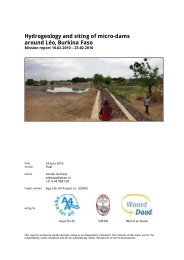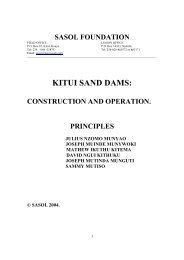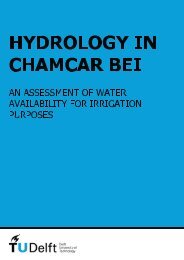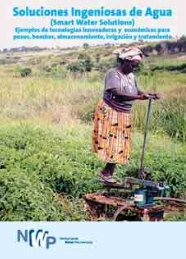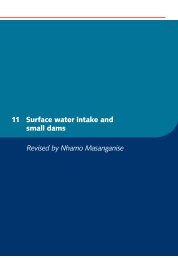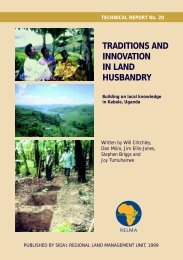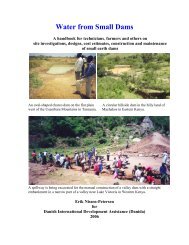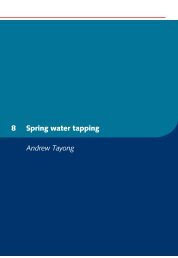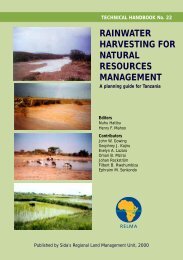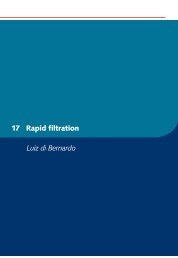Figure 6: Simplification <strong>of</strong> a <strong>solar</strong> <strong>still</strong> on a berkadDiscussion and recommendationsThe results presented above indicate that <strong>the</strong> <strong>implementation</strong> <strong>of</strong> a <strong>solar</strong> <strong>still</strong> on (already existing and new)berkads is a feasible measure for <strong>the</strong> improvement <strong>of</strong> <strong>the</strong> water quantity and quality in <strong>the</strong> village Budunbuto.Above this, it is generally agreed that <strong>solar</strong> <strong>still</strong>s are a good option in remote areas where <strong>the</strong> water demand doesnot exceed <strong>the</strong> 200 m 3 /day (Tiwari et al., 2003 and Fath, 1998). However, <strong>the</strong> approach used is very <strong>the</strong>oreticaland abstract, what inevitably may have lead to some inaccuracies:- The evaporation loss has been calculated based mostly on remotely sensed data, which is availableonly at a large scale for <strong>the</strong> studied location. This is a source <strong>of</strong> inaccuracy within <strong>the</strong> results <strong>of</strong> <strong>the</strong>Penman open water evaporation equation. However, it is important to notice that due to <strong>the</strong> availability<strong>of</strong> this data it is actually possible to make estimates over an o<strong>the</strong>rwise data scarce region.- The actual water consumption rate, and thus <strong>the</strong> amount <strong>of</strong> berkads needed with a <strong>solar</strong> <strong>still</strong> system,might differ from what has been estimated. This because <strong>the</strong> water consumption rates and <strong>the</strong> number<strong>of</strong> inhabitants <strong>of</strong> Budunbuto are also an estimation based on <strong>the</strong> little information that is available.- The <strong>the</strong>oretical approach used to estimate <strong>the</strong> output from <strong>the</strong> <strong>solar</strong> <strong>still</strong> is very abstract and might beinaccurate. On <strong>the</strong> o<strong>the</strong>r hand, this seems <strong>the</strong> most reasonable approach to use when estimating <strong>solar</strong><strong>still</strong> output <strong>the</strong>oretically, as it is possible to make assumptions for <strong>the</strong> efficiency <strong>of</strong> <strong>the</strong> system and <strong>the</strong>remaining parameters are all known.- The <strong>solar</strong> <strong>still</strong> design as described above resulted to be <strong>the</strong> most suitable for Budunbuto. However, as<strong>the</strong> approach used is very <strong>the</strong>oretical, it may not be <strong>the</strong> most functional design in practice. Therefore itis recommended to test various simple <strong>solar</strong> <strong>still</strong> designs during <strong>the</strong> pilot project. This could be done byconstructing both single and double slope <strong>solar</strong> <strong>still</strong>s, using plastic and glass top covers.Although <strong>the</strong> above described inaccuracies are present, <strong>the</strong> information <strong>of</strong> this report will provide a reliableguideline for <strong>the</strong> pilot project, during which <strong>the</strong> working <strong>of</strong> <strong>the</strong> system will be tested. It is expected that <strong>the</strong>actual production rate <strong>of</strong> <strong>the</strong> <strong>solar</strong> <strong>still</strong> will be within <strong>the</strong> range estimated and that <strong>the</strong> efficiency will most likelybe around 15%. However, to satisfy <strong>the</strong> water demand for animal watering and domestic use (about 35.5 m 3 /yr),more berkads are needed. These berkads obviously do not need a <strong>solar</strong> <strong>still</strong> system, as <strong>the</strong> water does not need tobe within <strong>the</strong> mineralogical and bacteriological standard used for drinking water.During <strong>the</strong> pilot phase <strong>of</strong> <strong>the</strong> project, it is advised to accurately measure both <strong>the</strong> quantity and quality <strong>of</strong> <strong>the</strong>water produced by <strong>the</strong> <strong>still</strong>. The electrical conductivity, pH, NO 3-and <strong>the</strong> alkalinity <strong>of</strong> <strong>the</strong> water should directlybe measured in <strong>the</strong> field. For <strong>the</strong> analysis <strong>of</strong> <strong>the</strong> major cations and anions, it is advised to take 10 ml samples12
filtered with a 0.45 μm membrane filter, which should <strong>the</strong>n be sent to a water laboratory. Also <strong>the</strong>bacteriological content <strong>of</strong> <strong>the</strong> water should be analysed, to make sure that <strong>the</strong> bacteria and viruses are actuallynot present in <strong>the</strong> drinking water. These measurements would certainly contribute to increase <strong>the</strong> knowledgeregarding <strong>the</strong> purification <strong>of</strong> contaminated water by using <strong>solar</strong> <strong>still</strong>s.Once <strong>the</strong> working <strong>of</strong> <strong>the</strong> system has proven to be effective, it is important that <strong>the</strong> water users are well informedabout <strong>the</strong> <strong>solar</strong> <strong>still</strong> in order to ensure its correct functioning and its sustainability. It is essential to emphasizethat <strong>the</strong> <strong>solar</strong> <strong>still</strong> will only produce <strong>the</strong> expected output when it is fully airtight. This means that <strong>the</strong> water inletshould never be opened by <strong>the</strong> users to extract <strong>the</strong> water from <strong>the</strong> berkads as <strong>the</strong> hand pumps should solely beused for that. The same holds for <strong>the</strong> drinking water tank which should also never be opened. Ano<strong>the</strong>r importantpoint is that <strong>the</strong> maintenance <strong>of</strong> <strong>the</strong> berkads is regularly carried out and that possible leaks are immediatelydetected and repaired. Particular attention should be paid for <strong>the</strong> drinking water tank, which is positioned in <strong>the</strong>ground, what makes it difficult to detect possible leaks.ConclusionsEven though <strong>the</strong>re are uncertainties associated with <strong>the</strong> <strong>the</strong>oretical and abstract approach used in this research,<strong>the</strong> results indicate that <strong>the</strong> <strong>implementation</strong> <strong>of</strong> a <strong>solar</strong> <strong>still</strong> on berkads can be a feasible measure to reduceevaporation loss and to improve <strong>the</strong> drinking water quality in Budunbuto.The production rate <strong>of</strong> di<strong>still</strong>ate water is estimated to be between 100 and 590 l/d per berkad depending on<strong>the</strong> efficiency <strong>of</strong> <strong>the</strong> system. Above this, rain water harvesting on <strong>the</strong> top cover <strong>of</strong> <strong>the</strong> <strong>still</strong> can contribute toincrease <strong>the</strong> water available with about 40 m 3 a year. This implies that Budunbuto would need between 3 and 11berkads to fully satisfy <strong>the</strong> drinking water demand <strong>of</strong> <strong>the</strong> village, which is a very realistic result. However, moreberkads (without <strong>solar</strong> <strong>still</strong>) are needed to satisfy <strong>the</strong> remaining water demand for animal watering and domesticuse (about 35.5 m 3 /yr).The water extracted from <strong>the</strong> drinking water tank is expected to be within <strong>the</strong> bacteriological andmineralogical advised quantities where no adverse health effects are observed. The di<strong>still</strong>ate is expected to bepartially re-mineralized during <strong>the</strong> mixing process with <strong>the</strong> harvested rain water. However, accurate monitoringand analysis <strong>of</strong> <strong>the</strong> water quality is advised during <strong>the</strong> pilot project.Based on <strong>the</strong> available information and based on <strong>the</strong> estimates made, <strong>the</strong> recommended design for <strong>the</strong> <strong>still</strong> isa single slope <strong>solar</strong> <strong>still</strong>, with an equator facing top cover placed at a 10º angle. The top cover should(preferably) be a glass top cover. Assuming an efficiency <strong>of</strong> 15% for <strong>the</strong> <strong>solar</strong> <strong>still</strong>, <strong>the</strong> drinking water tankshould have a capacity <strong>of</strong> 10 m 3 .To conclude, <strong>the</strong> <strong>implementation</strong> <strong>of</strong> a <strong>solar</strong> <strong>still</strong> on (existing) berkads seems to be a good option inBudunbuto, as with a low cost technology with low cost maintenance, it is possible to improve <strong>the</strong> quantity andquality <strong>of</strong> <strong>the</strong> available water.ReferencesAbbate et al.. (1994) Geological map <strong>of</strong> Somalia, scale 1:1,500,000. Florence, ItalyAl-Hayek, I. and Badran, O.O. (2004) The effect <strong>of</strong> using different designs <strong>of</strong> <strong>solar</strong> <strong>still</strong>s on water di<strong>still</strong>ation.Elsevier: Desalination 169:121-127.Badran, O.O. and Abu-Khader, M.M. (2007) Evaluating <strong>the</strong>rmal performance <strong>of</strong> a single slope <strong>solar</strong> <strong>still</strong>. HeatMass transfer 43:985-995.Banks, D. (2008) Potable water strategies Mudung, Somalia, with special reference to <strong>the</strong> local economics <strong>of</strong>motorised borehole systems for watering nomadic livestock. Hydrogeology Journal 16:765-777Brich, I. (2008) Somaliland/Somali region desk review. Securing pastoralism in East and West Africa:protecting and promoting livestock mobility.Boko, M., Niang, I., Nyong, A., Vogel, C., Gi<strong>the</strong>ko, A., Medany, M., Osman-Elasha, B., Tabo, R. and Yanda P.(2007) Africa. Climate Change 2007: Impacts, Adaptation and Vulnerability. Contribution <strong>of</strong> Working13



